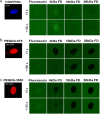Coatings on mammalian cells: interfacing cells with their environment
- PMID: 30675178
- PMCID: PMC6337841
- DOI: 10.1186/s13036-018-0131-6
Coatings on mammalian cells: interfacing cells with their environment
Abstract
The research community is intent on harnessing increasingly complex biological building blocks. At present, cells represent a highly functional component for integration into higher order systems. In this review, we discuss the current application space for cellular coating technologies and emphasize the relationship between the target application and coating design. We also discuss how the cell and the coating interact in common analytical techniques, and where caution must be exercised in the interpretation of results. Finally, we look ahead at emerging application areas that are ideal for innovation in cellular coatings. In all, cellular coatings leverage the machinery unique to specific cell types, and the opportunities derived from these hybrid assemblies have yet to be fully realized.
Keywords: Cell therapy; Cellular coatings; Coatings; Mammalian cells; Polymers.
Conflict of interest statement
Not applicable.Not applicable.The authors declare that they have no competing interests.Springer Nature remains neutral with regard to jurisdictional claims in published maps and institutional affiliations.
Figures

















Similar articles
-
[Applications of functional materials-based solid phase microextraction technique in forensic science].Se Pu. 2023 Apr;41(4):302-311. doi: 10.3724/SP.J.1123.2022.06018. Se Pu. 2023. PMID: 37005917 Free PMC article. Chinese.
-
[Advances in polydopamine surface modification for capillary electrochromatography].Se Pu. 2020 Sep 8;38(9):1057-1068. doi: 10.3724/SP.J.1123.2020.03004. Se Pu. 2020. PMID: 34213272 Chinese.
-
Interactions Between 2D Materials and Living Matter: A Review on Graphene and Hexagonal Boron Nitride Coatings.Front Bioeng Biotechnol. 2021 Jan 27;9:612669. doi: 10.3389/fbioe.2021.612669. eCollection 2021. Front Bioeng Biotechnol. 2021. PMID: 33585432 Free PMC article. Review.
-
Layers and Multilayers of Self-Assembled Polymers: Tunable Engineered Extracellular Matrix Coatings for Neural Cell Growth.Langmuir. 2018 Jul 31;34(30):8709-8730. doi: 10.1021/acs.langmuir.7b04108. Epub 2018 Mar 12. Langmuir. 2018. PMID: 29481757 Review.
-
Large-scale, thick, self-assembled, nacre-mimetic brick-walls as fire barrier coatings on textiles.Sci Rep. 2017 Jan 5;7:39910. doi: 10.1038/srep39910. Sci Rep. 2017. PMID: 28054589 Free PMC article.
Cited by
-
Design and Optimization of the Circulatory Cell-Driven Drug Delivery Platform.Stem Cells Int. 2021 Sep 22;2021:8502021. doi: 10.1155/2021/8502021. eCollection 2021. Stem Cells Int. 2021. PMID: 34603454 Free PMC article. Review.
-
Immunomodulatory Delivery Materials for Tissue Repair.Adv Healthc Mater. 2025 Jun 29:e2501400. doi: 10.1002/adhm.202501400. Online ahead of print. Adv Healthc Mater. 2025. PMID: 40583436 Review.
-
Enlightening advances in polymer bioconjugate chemistry: light-based techniques for grafting to and from biomacromolecules.Chem Sci. 2020 May 6;11(20):5142-5156. doi: 10.1039/d0sc01544j. Chem Sci. 2020. PMID: 34122971 Free PMC article. Review.
-
Cell Surface Engineering Tools for Programming Living Assemblies.Adv Sci (Weinh). 2023 Dec;10(34):e2304040. doi: 10.1002/advs.202304040. Epub 2023 Oct 12. Adv Sci (Weinh). 2023. PMID: 37823678 Free PMC article. Review.
-
Increased yield of gelatin coated therapeutic cells through cholesterol insertion.J Biomed Mater Res A. 2021 Mar;109(3):326-335. doi: 10.1002/jbm.a.37025. Epub 2020 Jun 20. J Biomed Mater Res A. 2021. PMID: 32491263 Free PMC article.
References
-
- Pathak CP, Sawhney AS, Hubbell JA. Rapid photopolymerization of immunoprotective gels in contact with cells and tissue. J Am Chem Soc. 1992;114:8311–8312. doi: 10.1021/ja00047a065. - DOI
Publication types
Grants and funding
LinkOut - more resources
Full Text Sources
Other Literature Sources

